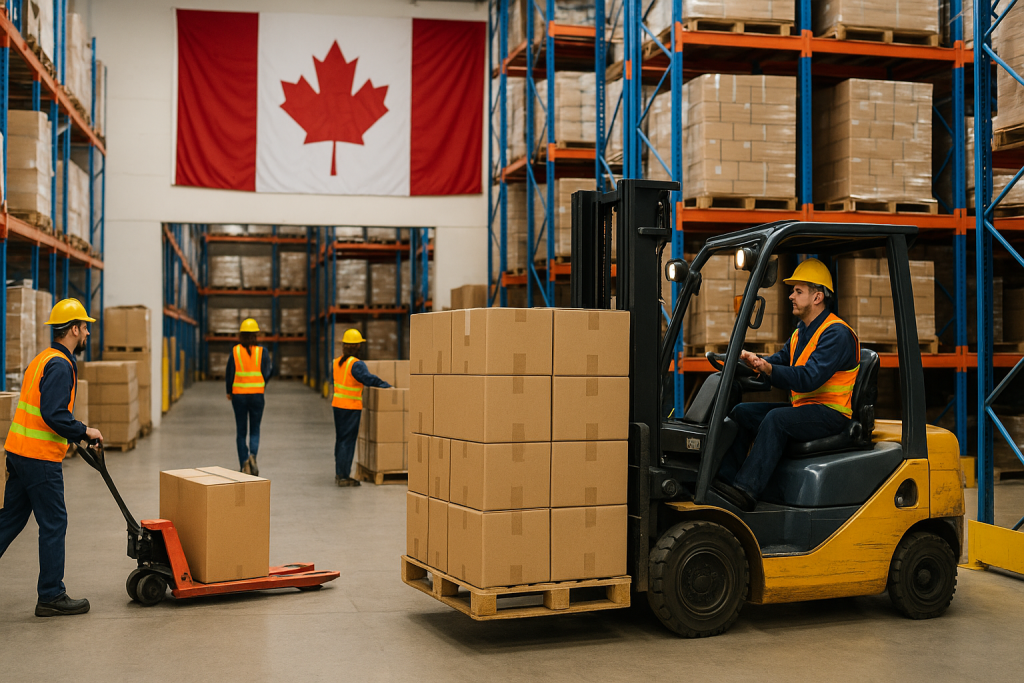By Martin Vassilev / 29 Sep, 2025
Ontario stands at the heart of Canada’s supply chain ecosystem, serving as a critical hub that drives the nation’s economic growth and cross-border trade. With its central location, robust infrastructure, and access to both domestic and international markets, Ontario warehousing plays a pivotal role in ensuring smooth distribution networks across North America. Businesses of all sizes—from e-commerce startups to multinational corporations—depend on the efficiency and reliability of Ontario’s warehousing solutions.
Ontario is strategically positioned with proximity to the United States border, including major entry points like Detroit and Buffalo. This location provides businesses with direct access to over 150 million consumers within a single day’s drive. Combined with world-class airports, seaports, and rail networks, Ontario makes distribution both cost-effective and time-efficient.
Ontario contributes significantly to Canada’s GDP and houses diverse industries—automotive, manufacturing, retail, and technology—that depend on seamless warehousing and logistics. With its growing e-commerce sector, demand for optimized warehousing in cities like Toronto, Ottawa, and London has surged.
Third-party logistics providers (3PLs) offer flexible storage and distribution services to businesses without the burden of long-term facility ownership. Many companies are shifting toward outsourcing due to reduced costs and operational efficiency (learn why outsourcing can be more cost-effective).
Enterprises operating at scale often build private warehouses to manage inventory independently. While this provides full control, it also requires significant investment in staffing, technology, and maintenance.
Given Ontario’s role in import/export, bonded warehouses allow businesses to defer customs duties until products are sold domestically, optimizing cash flow for international traders.
Ontario’s diverse climate and industries (pharmaceuticals, food, and agriculture) require specialized storage. Demand for temperature-controlled warehouses has risen, ensuring product safety and regulatory compliance (temperature-controlled warehousing guide).
Accurate inventory tracking ensures businesses avoid costly delays and stockouts. Smart warehouses in Ontario are increasingly adopting AI-driven systems to provide real-time visibility, reduce shrinkage, and improve decision-making.
Cross-docking solutions in Ontario help companies reduce storage time and speed up delivery by transferring shipments directly from inbound to outbound transportation. This is particularly valuable for retail and perishable goods (learn more about cross-docking benefits).
E-commerce growth has fueled demand for Ontario warehousing, especially with fast fulfillment needs. Businesses benefit from strategically located fulfillment centers that reduce last-mile delivery costs (the ultimate fulfillment guide).
Automated picking, packing, and robotics reduce human error while improving speed. Companies adopting these technologies are gaining a competitive edge in Ontario’s fast-moving logistics environment (future of warehouse automation).
AI plays a vital role in forecasting demand, route optimization, and managing complex supply chain disruptions. Ontario’s warehousing sector has seen significant adoption of AI for predictive analytics (AI in logistics insights).
Data-driven warehousing allows businesses to identify inefficiencies and optimize workflows, leading to improved profitability and customer satisfaction (data analytics in inventory management).
Ontario companies are increasingly adopting green warehousing practices to meet regulatory standards and customer expectations. Initiatives like energy-efficient lighting, solar-powered facilities, and optimized routing significantly reduce carbon footprints (Government of Canada sustainable supply chains).
Ontario is more than a regional hub—it connects Canada’s economy to the world. With trade agreements like USMCA, Ontario warehouses facilitate the smooth flow of goods across borders, ensuring Canadian businesses remain competitive internationally.
Investments in infrastructure, such as expanding rail freight and upgrading intermodal hubs, strengthen Ontario’s position as a logistics powerhouse. For example, the Toronto–Montreal–Windsor corridor remains one of the busiest and most vital routes for freight movement in North America.

Despite its strengths, Ontario warehousing faces several challenges:
Rising Operational Costs: Real estate prices and labor shortages drive up costs, forcing businesses to adopt lean warehousing solutions (lean warehousing guide).
Labor Market Pressures: Warehousing jobs are physically demanding, and turnover is high, pushing companies toward automation.
Supply Chain Disruptions: Global uncertainties—pandemics, political instability, and natural disasters—affect Ontario’s distribution resilience.
Sustainability Demands: Pressure to comply with stricter environmental regulations while maintaining cost efficiency.
Outsource Strategically: Partnering with 3PL providers reduces overhead and provides scalability.
Adopt Smart Technology: Automation, AI, and data analytics are no longer optional—they’re essential.
Leverage Cross-Docking: Reduces storage time and accelerates shipping for high-demand products.
Prioritize Green Logistics: Sustainable practices not only meet compliance but also attract eco-conscious consumers.
Plan for Scalability: Seasonal peaks, particularly in e-commerce, require flexible warehousing solutions.
Ontario’s warehousing infrastructure continues to evolve with technological advancements, sustainability initiatives, and strategic partnerships. It serves as the backbone of Canadian distribution networks, supporting businesses in meeting rising consumer expectations while maintaining efficiency. Companies that invest in Ontario warehousing gain a competitive edge in both domestic and international markets.
For tailored solutions that help businesses scale and streamline distribution, contact ByExpress today and discover how advanced warehousing can transform your supply chain strategy.

“Thanks to Byexpress all my shipping and fulfillment costs are in line now”

“All my issues were solved by Byexpress team that I had with pervious 3pl provider.”

“Thank you Byexpress team could not done it without you guys.”

“Their integration and customer service were the key for me”

“Outstanding delivery service! The package was well-packaged, and
the delivery team was professional and courteous”

“Great and knowledgeable team to work with.”

Thanks, guys, for reducing my shipping rates
Ottawa Office
2411 Holly Lane
Ottawa, ON, K1V 7P2
Toronto Office
13-280 West Beaver Creek Road Unit #136
Richmond Hill, ON, L4B 3Z1
Alexandria Office
173 Kenyon Street West
Alexandria, ON, K0C 1A0
Montreal Office
4388 Saint-Denis Street Unit #200
Montreal, QC, H2J 2L1
California Office
155 North Riverview Drive
Anaheim Hills, CA, 92808
Call Us
Toll-Free: 1-866-744-7122
Local : 613-739-3000
Email Us
Multilingual Services










